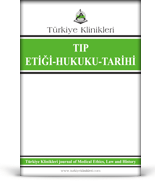Bu çalışma, hemşirelik öğrencileri için Meslektaş Şiddetine Maruz Kalma Ölçeği (MŞMKÖ)'ni geliştirmek ve psikometrik özelliklerini ortaya koymak amacıyla metodolojik olarak yapılmıştır. 2018- 2019 akademik yılında Giresun Üniversitesi Hemşirelik Bölümüne kayıtlı 153 hemşirelik öğrencisinden elde edilen veriler açımlayıcı faktör analizinde kullanılmıştır. Ölçek geliştirme sürecinin ikinci basamağı olan doğrulayıcı faktör analizi, 253 hemşirelik öğrencisi ile gerçekleştirilmiştir. Araştırma verilerinin toplanmasında, hemşirelik öğrencilerinin tanıtıcı özelliklerini içeren bir bilgi formu ile 'hemşirelik öğrencileri için MŞMKÖ' kullanılmıştır. Analizler sonucunda ölçek, 2 boyutlu ve 22 maddeli bir yapıya kavuşmuştur. Faktörler, 'sözel/psikolojik şiddete maruz kalma durumu' ve 'şiddetin fiziksel ve ruhsal sağlık üzerine etkisi' olarak isimlendirilmiş, bu iki faktörün açıkladığı toplam varyans ise %53,74 olarak bulunmuştur. Yapı geçerliliği için açımlayıcı faktör analizi yapılmış, ölçeğin Kaiser-Meyer-Olkin değeri 0,92 olarak bulunmuştur. Uyum indekslerinin beklenen değerler arasında olduğu görülmüştür. Cronbach alfa değeri 0,94 olarak hesaplanmıştır. Sonuç olarak, yapılan analizler MŞMKÖ'nün hemşirelik öğrencilerinin maruz kaldığı meslektaş şiddetini ölçmek için yapı olarak uygun, zamana göre geçerli ve güvenilir olduğu tespit edilmiştir.
Anahtar Kelimeler: Meslektaş şiddeti; hemşirelik; geçerlilik; güvenirlilik; öğrenci hemşire
This methodological study was conducted to describe the development of the Colleague Violence Exposure Scale For Nursing Students (CVESNS) and to determine its psychometric properties. The data obtained from 153 nursing students who enrolled in Nursing Department of Giresun University in the 2018-2019 academic year were used in exploratory factor analysis. Confirmatory factor analysis, that is the second step of the scale development process, was conducted with 253 nursing students. An information form including the descriptive characteristics of nursing students and the CVESNS were used in data collection. The scale has 2 factors and 22 statements according to content and construct validty tests. The factors were "the exposure to verbal/psychological violence" and "the effect of violence on physical and mental health", and the total variance explained by these two factors was found to be 53.74%. For the construct validity, exploratory factor analysis was done, and its Kaiser-Meyer-Olkin was determined to be 0.92. It was observed that fit indices were among the acceptable range. Cronbach alpha coefficient of the scale is 0.94. In conclusion, it was seen that the analysis performed showed that the CVESNS was suitable as structure and content and reliable for measuring the colleague violence experienced by nursing students.
Keywords: Colleague violence; nursing; validity; reliability; student nurse
- Becher J, Visovsky C. Horizontal violence in nursing. Medsurg Nurs.2012;21(4):210-32.
- Ayakdaş D, Arslantaş H. Colleagueviolence in nursing: a cross-sectional study. J Psychiatric Nurs. 2018;9(1):36-44. [Crossref]
- Longo J. Horizontal violence amongnursing students. Arch Psychiatr Nurs. 2007;21(3):177-8. [Crossref] [PubMed]
- Thomas SP, Burk R. Junior nursingstudents' experiences of vertical violence during clinical rotations. Nurs Outlook.2009;57(4):226-31. [Crossref] [PubMed]
- Ferns T, Meerabeau L. Verbal abuse experienced by nursing students. J AdvNurs. 2008;61(4):436-44.
- Budden LM, Birks M, Cant R, BagleyT, Park T. Australian nursing students' experience of bullying and/or harassment duringclinical placement. Collegian. 2017;24(2):125-33. [Crossref]
- Tee S, Üzar Özçetin YS, RussellWesthead M. Workplace violence experienced by nursing students: a UK survey. Nurse EducToday. 2016;41:30-5. [Crossref] [PubMed]
- Palaz S. Turkish nursing students'perceptions and experiences of bullying behavior in nursing education. Journal of NursingEducation and Practice. 2013;3(1):23-30. [Crossref]
- Koç M, Batkın D. [Nursing andmidwifery students' exposure to corker violence in practice settings]. Anadolu Hemşirelik veSağlık Bilimleri Dergisi. 2016;19(3):189-96. [Crossref]
- Celebioğlu A, Balci Akpinar R,Kücükoğlu S, Engin R. Violence experienced by Turkish nursing students in clinical settings:their emotions and behaviors. Nurse Educ Today. 2010;30(7):687-91. [Crossref] [PubMed]
- Ergöl Ş, Kürtüncü M. [Violenceexperienced by nursing students in clinical practice settings]. Journal of Higher Educationand Science. 2013;3(1):65-9. [Crossref]
- Lash AA, Kulakaç Ö, Buldukoğlu K,Kukulu K. Verbal abuse of nursing and midwifery students in clinical settings in Turkey. JNurs Educ. 2006;45(10):396-403. [Crossref] [PubMed]
- Aydın MF, Argun MŞ. [The expectations of hospital practices and facedproblems of the students in Bitlis Eren University, Health School, Department of Nursing].Acıbadem Üniversitesi Sağlık Bilimleri Dergisi. 2010;1(4):209-13.
- Birks M, Budden LM, Biedermann N,Park T, Chapman Y. A 'rite of passage?': bullying experiences of nursing students inAustralia. Collegian. 2018;25(1):45-50. [Crossref]
- Magnavita N, Heponiemi T.Workplace violence against nursing students and nurses: an Italian experience. J NursScholarsh. 2011;43(2):203-10.[Crossref] [PubMed]
- Güngör D. [A guide to scale development and adaptation in psychology].Türk Psikoloji Yazıları. 2016;19(38):104-12.
- Erkuş A. Psikolojide Ölçme ve Ölçek Geliştirme-1: Temel Kavramlar veİşlemler. 2. Baskı. Ankara: Pegem Akademi; 2014. p.173.
- Davis LL. Instrument review:getting the most from a panel of experts. Appl Nurs Res. 1992;5(4):194-7. [Crossref]
- Curtis J, Bowen I, Reid A. Youhave no credibility: nursing students' experiences of horizontal violence. Nurse Educ Pract.2007;7(3):156-63. [Crossref] [PubMed]
- Ayre C, Scally AJ. Criticalvalues for Law she's content validity ratio: revisiting the original methods of calculation.Measurement and Evaluation in Counseling and Development. 2014;47(1):79-86. [Crossref]
- Yeşilyurt S, Çapraz C. [A road map for the content validity used inscale development studies]. Erzincan Üniversitesi Eğitim Fakültesi Dergisi.2018;20(1):251-64.
- Karakoç FY, Dönmez L. [Basicprinciples of scale development]. Tıp Eğitimi Dünyası. 2014;40:39-49. [Crossref]
- Çokluk Ö, Şekercioğlu G, Büyüköztürk Ş. [Structural equation modelling].Sosyal Bilimler İçin Çok Değişkenli İstatistik: SPSS ve Lisrel Uygulamaları. 1. Baskı.Ankara: Pegem Akademi; 2010. p.251-407.
- Şencan H. [Validity]. Sosyal ve Davranışsal Ölçümlerde Güvenilirlik veGeçerlilik. 1. Baskı. Ankara: Seçkin Yayıncılık; 2005. p.723-99.
- Büyüköztürk Ş. Sosyal Bilimler İçin Veri Analizi El Kitabı: İstatistik,Araştırma Deseni SPSS Uygulamaları ve Yorum. Genişletilmiş 20. Baskı. Ankara: Pegem Akademi;2014. p.209.
- Özdamar K. Paket Programlar ile İstatistiksel Veri Analizi (ÇokDeğişkenli Analizler). 5. Baskı. Eskişehir: Kaan Kitabevi; 2004.p.528.
- Tabachnick BG, Fidell LS. Using multivariate statistics. 5th ed. USA:Pearson Education; 2001. p.528.
- Şahin MG, Boztunç Öztürk N.[Scale development process in educational field: a content analysis research]. KastamonuEğitim Dergisi. 2018;26(1):191-9. [Crossref]
- Kline RB. Measurement models and confirmatory factor analysis.Principles and Practice of Structural Equation Modelling. 2nd ed. New York: Guilford Press;2005. p.230-64.
- Yılmaz V, Çelik HE. LISREL ile Yapısal Eşitlik Modellemesi-1. 1. Baskı.Ankara: Pegem Akademi; 2009. p.127.







.: İşlem Listesi